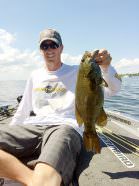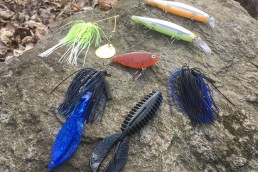Stay on the Move to Chase Down Springtime Bass
SHARE THIS POST
Just when you think you’ve located a nice group of bass this spring, you go back the next day or even later that day to find those fish in the morning, and bang, they are gone. That is the frustrating thing about spring bass fishing; just as quickly as you found them, they can move just as fast.
The reason for this is several things, but predominately it revolves around the bass’s spawning schedule. If the fish you found were in a pre-spawn location in the morning or later that day, and then the weather that afternoon or overnight warms the water temperature up enough to push those bass to the bank to begin their spawn, they will make a break for it and do their thing.
A great example of this is that a group of bass could be stacked up on a main lake point to a bay or cove. These bass are staging up to spawn. Once the water temperature warms enough, those bass will vacate this point and move into that bay and to the shoreline to begin making their beds.

When this situation happens, these bass will follow a break or inside weedline from that point into the bay. A great tactic to employ to locate and catch these bass again is to cover as much water as possible. This will eliminate the unproductive water in a short amount of time and trigger a reaction strike out of the bass. I’ll turn my Minn Kota Fortrex on 70 or 80 and cruise the shoreline from the point into the bay casting a lipless crankbait like a Rattle Trap if there is some grass starting to emerge. I’ll make sure the bait makes contact with that grass and then rip it out if it gets hung. If the stretch of water I’m fishing is barren of vegetation, I’ll use a medium diving crankbait such as a Rapala DT-6 or DT-10, or Strike King Series 4 or 5xd. Which one I use will depend on the depth of water I’m trying to hit.
Since the chances of encountering a spring shower during April are high and the possibility of a snow shower still exists, it is important to keep your expensive crankbaits safe from the elements. I rely on a deep 3700 Plano waterproof Stowaway. The depth of this case allows me to carry an adequate amount of cranks and importantly keep them dry.
Making long casts not only helps you cover water, but it also ensures your crankbait achieves its target depth. To aid in this, I’ll fish my crankbaits on Seaguar Inviz X 15-pound-test fluorocarbon line. Besides helping me make long casts, if my bait gets hung in some vegetation, a quick snap with the rod will have that bait pop erratically out of that vegetation and likely trigger an inactive bass into biting.
Another scenario in which spring bass will move quickly is on a river system. Any time you are fishing a river, such as the Mississippi, the current plays a major role in when and where those bass will position themselves. As the month of April progresses, the likelihood of the water levels and current flow increasing goes up. This is because of the snowmelt and spring rains entering the river system.
Are you enjoying this post?
You can be among the first to get the latest info on where to go, what to use and how to use it!
As the water begins to warm and the flow on the main river is still low, both largemouth and smallmouth will be positioned on points or stretches of bank that are located between their wintering areas and their spawning grounds, these areas have a viable amount of food for them. But once the flow cranks up, those bass will scatter and begin moving to their backwater spawning areas.
Along the way, those bass will hit up and hide behind current breaks. These breaks give those bass a chance to rest up out of the current and pick off food as the current pushes it by. Once those bass are ready and the water temperatures are right, they’ll make that final push to their spawning areas.
For largemouths, I like to slow roll a single Colorado blade spinnerbait around deep wood and on points. This allows me to cover water, and then once I locate a sweet spot, I’ll slow down and drop my 12-foot Minn Kota Talon and fish a 1/2-ounce black/blue jig with a Zoom Super Chunk on the back.
What makes the jig versatile this time of year is that I can also cast it out and drag it along a sand point that is acting as a current break for smallmouth, which can be a staging area for them or even a spawning spot. The new Wright & McGill Victory Pro Carbon Jig 7-foot, 4-inch rod allows me to present my jig either by casting it out and dragging it back in or flipping it to visible cover.
As you begin your quest for spring bass on your favorite lake or river, be aware that those bass you find will move and be ready to pick up a reaction bait and cover water to relocate those fish. It may take some time, but once you get that bite dialed back in, you will have a rewarding day on the water knowing you were able to stay in front of spring bass.
Glenn Walker is a tournament fisherman who loves to spread his passion and knowledge of the sport through articles and videos. Contact: glennwalkerfishing.com, facebook.com/glennwalkerfishing.
MWO
SHARE THIS POST
You may also like...
0 CommentsGreat Shallow-water Bass Action Right Now
Did you enjoy this post?
You can be among the first to get the latest info on where to go, what to use and how to use it!
Glenn Walker
Glenn Walker has been fishing Minnesota and Mississippi River tournaments for more than 15 years, spreading his passion and knowledge of the sport via articles and videos. For more information, check out glennwalkerfishing.com or on Facebook @GlennWalkerFishing.


